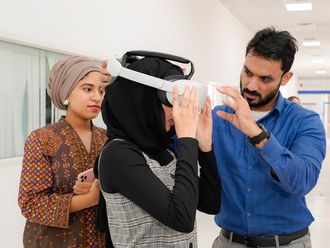
Dubai: Diabetic patients registered with the Dubai Health Authority (DHA) will now have a revolutionary non-invasive glucose monitoring system available beginning next week, instead of the painful needle pricks they traditionally have to subject themselves to, said DHA officials.
The no-finger prick flash glucose monitoring system provides round-the-clock monitoring. Patients need to stick on a sensor and they can scan themselves as many times in a day as they like. The scan takes only one second and shows patients their current glucose reading, an eight-hour glucose history and a trend arrow that depicts where their blood sugar is heading.
In the UAE, almost 20 per cent of the population is diabetic and another 20 per cent is pre-diabetic. Monitoring glucose levels is part of a diabetic’s daily routine and is important to keep complications at bay and manage the disease.
DHA will distribute the device — Abbott’s Free Style Libre — to its registered patients at Dubai, Latifa and Rashid hospitals and the Dubai Diabetes Centre.
Humaid Al Qutami, chairman of the board and director-general of DHA, said, “Providing this state-of-the-art device to diabetics will lead to an enhanced monitoring of glucose levels, better quality of life for our patients and a drop in the rate of diabetes complications.”
Dr Ali Sayed, director of Pharmacy at DHA, said: “Traditionally a person with diabetes self-monitors their glucose by pricking their fingers routinely to check their glucose level so that he can adjust insulin, diet, and activity to achieve good glycaemic control. The new flash glucose monitoring system eliminates the discomfort associated with pricks; the sensor is a stick-on, needs to be changed every two weeks and is waterproof. The scan takes only one second, is accurate and provides details of current blood glucose levels and an eight-hour history. We are certain all these features will significantly improve the lives of our diabetic patients, especially our paediatric patients [who are above four years of age and use the device under adult supervision] as this system is easier to use than the finger prick testing.”
Dr Sayed added that this will significantly minimise life-threatening complications such as diabetic coma which can occur when a diabetic’s blood sugar rises (hyperglycaemia) or when it falls dangerously low (hypoglycaemia).












